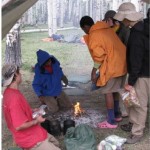May 01, 2014
The Effectiveness of Wilderness

Why Choose Wilderness?
Summer is just around the corner, and with its warmth and sun-filled days, summer also brings a variety of treatment opportunities for families in need. Wilderness settings can be an ideal option for families looking for residential treatment facilities after traditional, in-town approaches have not succeeded. Wilderness settings offer students fewer distractions and the chance to detach from technology and the attractions of home. Wilderness therapy is different from traditional treatment, such as individual or group therapy because of the inherent challenges of living outdoors. A wilderness setting is “truly the most effective therapeutic approach for adolescents and young adults,” states Dr. Milton D. Little, Psychologist and Educational Consultant.
Wilderness programs offer a wide range of services to students and families. They are diagnostic, therapeutic, and evaluative. In addition to therapy, students will engage in activities that can range from survival skills to yoga to art therapy. Students are given the opportunity to develop new coping mechanisms, improve communication techniques, and solve problems. Wilderness programs have proven over they last ten years, through the Outdoor Behavioral Healthcare Council, to show a significant reduction in psychological problems such as anxiety, depression, ADHD, substance abuse and suicidality. They have also found that adolescents and young adults are safer in a wilderness program than being at home, and that they are more successful in their next program or school.
Getting out of the rain under Big Brown (group tarp) at Second Nature
Choosing the right wilderness facility can be a daunting task for families, however, and they may feel saddened at the thought of sending their child away. When multiple factors are contributing to a student’s downward spiral, getting them out of their regular environment for a period of time can be the one of the best interventions. Using a certified educational consultant will allow families to choose a facility that will best fit their child’s needs. Wilderness and treatment programs can be found in Utah, North Carolina, Georgia, Oregon, Hawaii, Maine, and Samoa for children as young as 11 as well as adolescents and young adults. Families will find comfort in the fact that their choice has been vetted and approved by a professional in the field, and they will know their child is receiving the help he or she requires.
